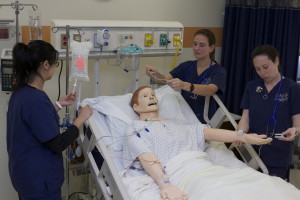In a $608,000 makeover, Pace University”™s College of Health Professions installed video cameras, patient monitors, headboards and a control room in two newly reconfigured labs. Mannequins in hospital beds wearing breathing tubes and armbands feature fake wounds and droplets of sweat to resemble real patients. Students in the college”™s registered nursing, accelerated B.S. in nursing, family nurse practitioner and physician assistant programs can now access 4,276 square feet of academic space in six labs as they tend to their human simulator patients in lab exercises using enhanced technology for more hands-on training.
The new technology in the simulation labs will give Pace students a competitive edge in the workforce, said Geraldine Colombraro, associate dean for Pace”™s College of Health Professions.
“Hospitals and other health care organizations seek out students with simulation on their resumes,” Colombraro said. “Our students have a competitive advantage when they graduate because they”™ve done simulation. It shows potential employers that they”™ve worked in teams to solve problems and that they”™ve been exposed to complicated or high risk scenarios.”

Each of the six labs is fully equipped with tools such as monitors and respirators to help students learn patient care skills, familiarize themselves with the medical equipment and make decisions in medical exercises. Students interact with standardized patients or actors hired by the school for training in medical situations. These standardized patients stick to certain scripts and act out the scenes in a way that cues students to use their clinical reasoning and critical thinking skills.
“We enact various characters according to guidelines,” said Leigh Trifari, a Pace standardized patient actress. “Sometimes we have a script of character description and we improvise our responses and create a back story. We acted out a scenario where a set of parents had a daughter with traumatic brain injury and they had to decide whether to pull the plug. We know how to react as patients and respond in a way that will give the students the proper learning experience.”
The control room allows faculty members to separate themselves from the students and still observe their performance. The students are encouraged to suspend their disbelief and fully immerse themselves in the lab exercises. The video cameras help students review their performance and debrief with faculty members after each lab exercise.
“We take a look at what happened and what should”™ve happened,” said Elizabeth Berro, co-director and professor of Pace”™s clinical lab. “We find out what was going on in the student”™s head. Did they know an oxygen device was needed? Through the debriefing process, we know exactly where the students”™ level of understanding is and we”™re able to clarify what the missing pieces of information were for each of them.”
The College of Health Professions plans to open its simulation labs to Pace”™s clinical partners and even develop partnerships with area hospitals, which would give nursing employees opportunities to re-learn and develop critical clinical skills, said Marybeth Carpiniello, Pace clinical education labs manager.
“We would like to partner with different hospitals in Westchester and re-certify employees through programs in our simulation labs,” Carpiniello said. “We”™re trying to share our resources with hospital employees and nurses to provide a platform for continuing education.”
The renovated lab provides more space for Pace students across all the health profession programs to learn and practice basic skills training in group settings. The simulation labs will run more than 500 classes and activities this semester ranging from tutoring to skills development training, Berro said.
“We want to teach students about patient safety, emergency situations and how to improve communication among health professionals starting at the classroom level,” Berro said.


















